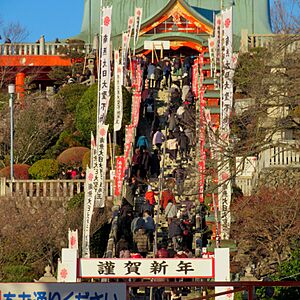Hatsumōde facts for kids
Hatsumōde (pronounced HAH-tsoo-MOH-deh) is a special Japanese tradition. It's the very first visit to a Shinto shrine or Buddhist temple of the Japanese New Year. Many people go on January 1st, 2nd, or 3rd. These are often days off from work or school for most people.
During Hatsumōde, people usually make wishes for the new year. They might wish for good health, success in school, or happiness for their family. It's also a time to buy new omamori (OH-mah-mah-ree), which are special charms or amulets. These charms are believed to bring good luck. Old omamori are brought back to the shrine or temple. They are then respectfully burned. This is a way to thank them for their protection.
You might see very long lines at popular shrines and temples during Hatsumōde. Millions of people visit these places in the first few days of January.
New Year's Traditions
Most people in Japan have a holiday from December 29th to January 3rd. During this time, families get ready for the new year. They clean their homes and visit friends and relatives. Gifts are often exchanged.
On New Year's Day, many families start the morning with a short worship at home. Then, they enjoy special New Year's food. This includes sake (rice wine) called toso and dishes like osechi and zōni (a soup with rice cakes). The visit to the shrine or temple is usually quick and personal.
Popular Places to Visit
Some shrines and temples welcome millions of visitors during Hatsumōde. Sensoji Temple in Tokyo is one of the most visited. For example, Meiji Shrine had 3.2 million visitors in the first three days of January 2010. Other very popular spots include Narita-san, Kawasaki Daishi, Fushimi Inari-taisha, and Sumiyoshi Taisha.
Omikuji: Fortune Telling
A common custom during Hatsumōde is to buy an omikuji (OH-mee-koo-jee). This is a written oracle or fortune. It tells you about your luck for the year ahead. It's a bit like a horoscope.
Your omikuji will give details about different parts of your life. It might tell you about your studies, friendships, or future plans. If your omikuji predicts bad luck, don't worry! You can tie it onto a tree branch at the shrine. This is done in the hope that the bad prediction won't come true. Often, a small good-luck charm comes with the omikuji when you buy it. These charms are believed to bring good fortune and money.
Ninenmairi
Ninenmairi (NEE-nen-MY-ree) is a special way to do Hatsumōde. It means "two-year visit." This is because the visit starts on New Year's Eve and finishes on New Year's Day. So, it happens over two different years!
People often write their wishes for the new year on Ema. These are small wooden plaques. They are then hung at the shrine. Many people also eat Toshikoshi-soba (buckwheat noodles) about an hour before midnight on New Year's Eve. This is a tradition to wish for a long life.
See also
 In Spanish: Hatsumōde para niños
In Spanish: Hatsumōde para niños
- Saisaki-mode
- Ōmisoka


